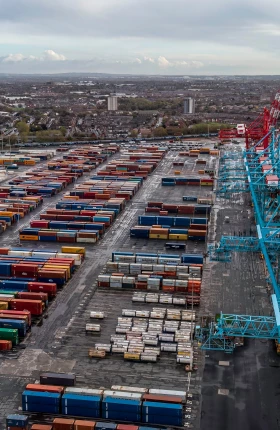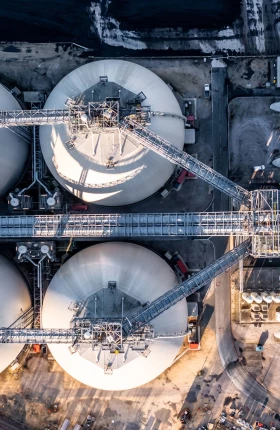Executive Summary
The answer is not simply to spend more. Fundamentally, our delivery of infrastructure must improve. Pushing more money through a struggling pipeline is not a solution. To fix this, we must understand why the UK has been poor at delivering infrastructure and what lessons we can learn from those who do it better.
Often this is put down to less favourable economic fundamentals in the UK, such as construction labour cost and productivity, land cost and population density. While the UK is a challenging place to build large infrastructure, the data suggests the differences are not sufficiently large to fully explain the performance gap we see. Fundamentally, differences in how projects are delivered play a significant role.
BCG’s Centre for Growth examined data from 2,300 infrastructure projects across 16 countries from the past two decades to benchmark and better understand the UK’s performance against peer countries. We found that:
- Across all forms of infrastructure, the UK faces a worrying combination of high costs and slow delivery. Unit costs for like-for-like projects are higher than European peers – on a par with US and Australia – but delivery times are in line with slower European peers.
- In absolute terms the UK’s unit costs for road and rail projects are higher than peer countries (France, Germany, Australia and US).
- The UK struggles to do the basics well, with the mean unit cost for flat rail construction twice as high as the global average in our dataset.
- Delivering flat road projects in the UK is twice as expensive as in France. The average cost for a flat road in the UK is £8.45 million per lane km, compared to the European average of £5.77 million per lane km and £4.22 million per lane km in France.
- Similarly, UK road projects face both the highest regularity (69%) and severity (66%) of cost overruns compared to peer countries.
- The UK also performs poorly at rural projects in terms of unit costs versus comparators, though it does relatively well at urban projects.
- The pre-construction phase in the UK is the slowest across our peer group; 65 months compared to an average of 50. For rail projects the UK is 50% slower than average, and for road and social 25% slower. Planning is a big part of this, but having to regularly repeat design phases also likely plays a role.
- No country is perfect – all see very regular cost overruns and delays in delivering projects.
Based on our data and four case studies across road, rail, social and energy infrastructure, there are a series of six common challenges which emerge across the project lifecycle of infrastructure in the UK. Many fall outside of the construction phase:
- The government often sets multiple, conflicting objectives for a project, with only loose budget and time constraints – this drives up cost and time, since it leads to incorrect specification choices which are often more costly or need to be changed and poor design choices which have to be repeated later in the project once the real objective becomes clear. It also confuses the process of democratic approval since the public are not aware of what the project is trying to achieve.
- Risk aversion means designs are frequently changed and are often over-elaborate, with too little attention paid to value or how the project will be built and operated – there is a failure to target the minimum viable product, instead focusing on a design that will avoid any objections. There is also little leveraging of what has worked well elsewhere in the UK or globally. Those responsible for operating and maintaining the asset are not involved in design or construction, resulting in multiple iterations before the asset comes into operation.
- The planning process is too long and complex, with multiple veto opportunities, adding process with little view on cost and time implications – permissions and approvals take far too long. Required feasibility assessments are over complicated. Consultations often take place multiple times with designs changing every time, partly as they seek to cover every stakeholder possible with no reference to which ones are most important. Early engagement can be beneficial, but mainly if it focuses on the ‘mission’ of the project and how it can unlock benefits for the public.
- The current sourcing and contracting approach creates an illusion of risk reduction, but actually often just shifts risk rather than effectively managing it, which creates perverse incentives – too much emphasis is placed on passing risks along the supply chain, masking the location of the risk instead of taking shared ownership of it across the whole ecosystem. Contracts can never fully account for risks. They often miss the actual source of the risk and ultimately the client (usually the government) will always retain a share of that risk – all meaning incentives to keep time and cost down are limited. The emphasis is on perceived predictability over efficiency.
- External pressure to move to construction despite repeated changes means designs are often immature and engineering risks not fully understood – repeated changes to designs (often from the consultation process) and lack of upfront investment in detailing designs, or exploring engineering risks, can drive up costs and cause delays as problems are found later in the process, with earlier stages then needing to be repeated.
- The UK construction industry is fragmented with little incentive or opportunity to invest in capital, skills or technology – many small firms are required to deliver projects; this increases costs and complexity on individual projects and means none of the firms have the incentive or ability to invest. There is no clear strategic objective across UK infrastructure and no real process to ensure lessons are learnt across the piece and that economies of scale are leveraged. This all results in wide variations in productivity across the sector.
Thankfully these problems are not insurmountable but bold action is needed. We see three urgent steps that are required from across the industry.
Take risk out of the system with a bold long-term agenda – adopt a more strategic approach to infrastructure focused on economic needs. Strengthen government leadership to maintain a clearer project pipeline to de-risk industry investment and innovation, as well as allowing economies of scale to develop to bring down costs.
- Creating an empowered Centre for Infrastructure Excellence focused on enabling government to be an effective client and providing an incentive for the supply chain to invest and innovate by reducing uncertainty and risk. Give a clear strategic approach to the entire portfolio of UK infrastructure projects. This new Centre should work right across the supply chain to help drive down costs. It will require new capability, deep industry knowledge and much better collection and use of granular cost and productivity data. Many organisations valiantly try to do this now, but they are often not empowered and some functions fall between them.
- Reforming the planning process, including focusing on ‘least bad’ options for vital infrastructure, willingness to increase compensation if it improves delivery times and reusing data or mitigations where they have already been shown to be successful.
- Setting clear well-defined objectives and ensuring they don’t conflict.
- Targeting the minimum viable product (especially for design and specifications) and reducing risk averse gold plating.
- Linking construction, delivery and operation so all responsible parties are joined up.
- Leverage contracts with more active ownership models, focusing on more effective and collaborative management of risk across entire project rather than passing risks along the supply chain (which rarely works in reality).
- Rethinking risk management in a quantitative way to better address the larger tail risks and avoid spurious certainty.
The UK is approaching a crossroads when it comes to its
infrastructure
. Over the coming decades, the
energy transition
and impacts of
climate change
will require larger and, in many cases, more complex infrastructure. This is true for most developed economies, but the UK approaches this having significantly underinvested in infrastructure compared to peers. UK overall investment averaged 19% of GDP in the 40 years to 2019, the lowest in the G7.
The National Infrastructure Commission (NIC) has estimated that both public and private sector infrastructure investment will need to increase by 30% to 50% over the next decade.

All this comes at a time when there is mounting evidence that the UK’s infrastructure is not working as it should. Our infrastructure underpins everything we do. From energy prices to the cost of housing, if the UK’s infrastructure is not functioning well, economic growth, productivity and our standard of living will suffer. On the flip side, delivering infrastructure projects on time, at reasonable cost and as part of a stable long-term pipeline can be a boom to the economy across the UK. If we have any hope of improving economic growth and meeting the needs of future generations, we must improve our approach to infrastructure delivery.
Understandably, there has been much focus on what infrastructure the UK needs to build, whether it is part of the energy transition or to promote regional economic growth. But we believe this is not the right starting point. First, we must understand the extent to which the UK’s delivery of large infrastructure projects has strayed off track, why this has been the case and how we can begin to fix it. Pushing more money and projects into a failing template is not a solution.
Subscribe to our Public Sector E-Alert.
Section 1: Benchmarking UK Performance
To understand what we need to fix, we need to understand the scale of the challenge. The UK’s performance in the infrastructure space is much maligned – understandably so. But no developed democracy is perfect in its delivery of infrastructure. All must grapple with similar challenges around high labour costs, expensive real estate, dense urban populations and complex public approvals. For example, Germany is renowned for its engineering prowess, yet the recently opened Berlin Brandenburg Airport came in three times over budget and nine years late.
There is a wide-ranging set of academic literature on infrastructure delivery. It reveals a common picture of near-ubiquitous overruns for both cost and schedule – but is highly varied on the extent and drivers of these overruns. For example, Flyvbjerg, et al. 2016 used a dataset of 1,603 projects globally and estimated an average cost overrun of 39% across all infrastructure projects, 40% in rail projects and 24% in road projects.
In the UK there have been several reviews looking at performance in infrastructure delivery. The UK government’s own figures on National Significant Infrastructure Projects show that between 2012 and 2021 delivery time increased by 65% – much of this due to the long and cumbersome pre-application process.

Exhibit 2 compares the UK delivery of road, rail and social infrastructure to a peer group of countries to benchmark its performance across several key metrics: unit cost, time to delivery, time overruns and cost overruns. The data is drawn from BCG’s in-house Prism database which includes detailed information on 2,300 infrastructure projects from 16 countries.
Exhibit 2 shows that, across all types of infrastructure projects, the UK is neither the worst performer nor the best. The median infrastructure project in the UK, when compared to like-for-like projects in peer countries, experiences unit costs which rank in the 52nd percentile. This means it falls roughly in the middle, in terms of unit cost relative to similar projects across similar countries. Notably, however, UK projects tend to come in at higher unit costs compared to European peers, but below the US and Australia.

Digging deeper into specific types of infrastructure shows that when it comes to social infrastructure the UK performs better, coming in above France and the European average, but below US, Australia and Germany (Exhibit 3). However, the UK performs poorly in terms of unit costs when it comes to rail and road: the UK’s absolute unit costs are higher than all other peer countries in our dataset.

The data can also tell us something about the drivers of these higher unit costs, though there are plenty of areas for further exploration given our data focuses primarily on time and cost. Building rail tunnels is significantly more costly than at-grade or bridge construction – highlighting the fact that choosing tunnels to placate public concerns over changing the look of the countryside, or similar reasons, does incur very real costs. But even at-grade rail construction in the UK is costly – in fact it is twice as high as the global average in our dataset. This suggests that even the most basic forms of construction are costly in the UK. We need to do the basics much better.
It is worth noting here that two very large and complex urban rail projects for the UK, Crossrail and the Northern Line extension, mean that the performance for high-cost rail projects is significantly worse than every other country. If these are removed, the UK is in line with peers. Both these projects delivered significant net benefits, so it is important to remember the context. But it does highlight that choosing complex, underground, heavy rail projects involves significantly more cost than light rail or tram projects, for example.
The story for road projects is similar. UK at-grade road projects came in at the second highest amongst peer countries, below only Australia. Germany, the top performer, delivered all their at-grade road projects on time while the UK delivered 64% late. UK projects were on average twice as expensive than Germany’s. Furthermore, smaller road projects in the UK are significantly more costly than peer countries. Once again, this reinforces the need to do the basics better. There are, of course, other issues which our data doesn’t cover in depth which could explain some of the higher unit cost for roads. For example, the number of turns and curves in a road will have an impact on its cost.

Unlike all other peer group countries, the UK also sees relative unit costs increase for rural projects compared to urban ones. UK rural projects tend to be more costly compared to similar projects in other countries (Exhibit 5). This surprising result is driven partly by the UK performing relatively well on urban projects but also by poor performance on rural road projects, combined with the fact that the UK delivers very few non-road rural projects. As we can see, there is already an emerging trend whereby the UK performs poorly at projects where actual construction costs and complexity are expected to be relatively low.
For infrastructure projects, time is just as important as money – probably more so. Exhibit 6 shows the median UK project lies at the 65th percentile, meaning it takes longer than 65% of similar projects. This is broadly in line with the rest of Europe where projects are consistently delivered more slowly. By contrast, the US and Australia complete their projects relatively much more quickly. Taken alone, this isn’t concerning; but when we link it to our cost data above it paints a worrying picture for the UK. Generally, European countries deliver at lower cost but over longer timelines, whereas the US and Australia have higher unit costs but shorter delivery timelines. The UK has the worst of both worlds: US and Australian levels of unit costs, with European timelines for delivery.

This begs the question as to whether the UK’s high unit costs and long timelines are the result of consistent time and cost overruns for projects.
Looking at cost overruns, there is a surprising amount of consistency across our country group (Exhibit 7). Essentially, apart from the US, no other country does particularly well. Cost overruns are incredibly common – in fact they are by far the norm for the UK, Germany, France and Australia. Furthermore, when costs do overrun, they are consistently large. France performs best with an average cost overrun of 47% (for projects that go over budget), an astonishingly high level for the best performer.
There is an important caveat here, however. Typically, for large-scale infrastructure projects, they will use a ‘P50 schedule’ when it comes to cost estimates: this means it has a 50% probability of being exceeded. As such, we would expect around 50% of projects to run over budget. It also means that if, as in the case of the US, the number of projects coming in above budget is significantly below this, it may suggest that infrastructure budgets are overinflated and capital is being deployed inefficiently. While cost overruns are very common and very large when they do occur in the UK, the UK is not an outlier here.

There is more nuance to the picture when looking at different types of infrastructure. For rail projects the US is again an outlier in terms of reducing how often costs overrun; however, when they do overrun, they overrun significantly. For rail projects the UK is middle of the pack in terms of how often costs overrun, but comes in second (just behind France) for the size of the overruns.
When it comes to road projects, the UK sees the highest regularity of overruns along with Australia, although Germany is close behind. But here the average size of overrun is largest for the UK at 66% of original budget. Clearly, the combination of 69% of road projects overrunning and the average overrun being 66% of the original budget is a major problem for the UK. This also probably goes some way to explaining the UK’s high unit cost for road projects.
For social infrastructure, the UK is approximately average for the proportion of projects over budget (61% vs 57%). But as with road, the UK is poor at mitigating the extent of overruns (56% vs 46% average, 32% for Germany).
When it comes to time overruns, the story is again one of a fairly consistent problem across all countries – albeit to a lesser extent than cost overruns (Exhibit 8).
Although the UK’s performance isn’t out of line with expectations, given the approach to scheduling, it is still comparatively worse than peers regarding time overruns. The US and Australia are best at preventing overruns, but worst when they do occur. Just as with cost, France performs best at limiting the size of overruns.

The UK has the second lowest length of time overruns for rail projects when they occur (after France) and is in the middle of the pack for how often rail projects are delayed. It is interesting that the UK does not perform poorly on time or cost overruns for rail projects, yet has the highest unit cost of our country group. This suggests that some project fundamentals are causing higher costs rather than delays or running over budget.
The story for UK road projects in terms of delays is similar to that for cost overruns. Delays in the UK are more common than elsewhere, with 58% of projects finishing late. However, they are on average 29% later than estimated, in line with the overall average in our dataset.
Finally, on social projects the UK ranks third in terms of how often delays arise – but when there are delays, they are on average the longest. When social infrastructure projects in the UK are delayed it is on average by 48% of original time estimated to completion, ten percent above the next highest, Australia.
All this paints a concerning picture for the UK in which we struggle to do the basics – such as delivering at-grade road projects at a competitive cost – and struggle to deliver large complex projects such as urban heavy rail. While we are not the worst on either time or cost, when the two are combined, we perform uniquely poorly on both.
Section 2: Why Does UK Infrastructure Face High Unit Costs and Long Delivery Times?
This benchmarking can only take us so far. We still need a more granular understanding of why the UK incurs higher unit costs than European peers, yet still delivers on similar timelines.

This is often put down to fundamental economic differences such as labour cost, labour productivity, land cost and population density. It’s true that these can play a role but, as Exhibit 9 shows, the UK is not subject to substantially higher construction labour costs than European peers – it is in the middle of the pack and actually below France and Germany. While all countries have seen construction productivity struggle over the past two decades, the UK actually does reasonably well when looking at the post-financial crisis trend. Our dataset highlights the fact that more infrastructure projects in the UK end up being classified as urban or suburban due to the regularity with which they come into contact with denser populations. But as we noted above in Exhibit 5, the UK actually does quite well on its relative unit costs for urban projects, while France has significantly lower unit costs across infrastructure in all locations. Both suggest that the performance gap isn’t down to density. This also suggests that land prices are not a fundamental driver, given that urban land in the UK is likely to be the most expensive.
The UK’s slow and costly planning system is well documented and is rightly identified as part of the problem. But the UK is also not alone in facing this challenge. Exhibit 10 shows the amount of time spent on pre-construction (of which planning is a major part) and construction phases for infrastructure projects. It highlights the fact that across all project types the UK is the slowest at pre-construction. For rail projects it takes 50% more time than the average, for road and social 25% more.

While lengthy timelines can be an indicator of delays and inefficient planning processes, it is not as simple as just shortening the time taken; rather it is a matter of how effectively the time is used. French roads are a good example of a longer but more effective use of time. Their pre-construction phase is 40% longer than average but their unit costs are the lowest across all peer groups and nearly half that of the UK (£4.24 million per lane/km compared to £7.77 million per lane/km). France focuses on early feasibility stages for major infrastructure projects prior to any formal consenting process. This involves an extensive consultation on the fundamental objectives of the project rather than purely specific designs.
While economic fundamentals are part of the problem, these alone cannot fully explain why we see a combination of high unit costs and slow delivery times in the UK compared to peers. There are a wider range of issues in project delivery that drive up unit costs and cause time and cost overruns.
To fully understand these, we analysed four case studies across four types of infrastructure (road, rail, nuclear and social), using a common project lifecycle framework. The framework highlights each key stage of the process from the inception of a project to its operation. We then identified a series of common issues at each stage of the project lifecycle which increase cost and delay delivery, as well as introducing uncertainty more broadly. To develop the case studies, we interviewed experts and conducted desktop research using publicly available sources. All information used is in the public domain.
Standardised framework for comparing case studies

As highlighted by the fact that more time is often spent on pre-construction phases than construction itself, the importance of the four phases before construction and delivery are commonly underestimated. The approach taken in these phases is equally important, if not more so, than the delivery and construction phase. By the time the construction phase is reached, a large portion of the cost of the project is usually already fixed – so any changes after this point therefore become incredibly costly and time consuming.
Exhibits 11.1-11.4 below show our four case studies: Crossrail, the A27 bypass at Arundel, Hinkley Point C and the Royal Liverpool Hospital. All of these are important and worthwhile projects. We have chosen them precisely because they are projects which, in our view, were important to pursue and which deliver net positive impacts. However, all displayed well-documented challenges and issues, as well as many positives. The case studies are designed to draw out key learnings and lessons from different stages of these projects.
There are several common themes that begin to emerge across these case studies. Combined with our learnings from the benchmarking above, Exhibit 12 brings these together to give a summary of why we believe UK infrastructure projects see higher unit costs and long delivery timelines. These are common across most, if not all, types of infrastructure.

Section 3: Learning From Best Practice Globally
Having identified some of the common causes of high unit costs, long delivery timelines and projects coming in late and/or over budget, we have brought together a series of best practices in the UK and globally to examine how these challenges can be overcome or avoided altogether.
3.1 Need and outcomes
Poorly defined outcome/objectives: Too often there is a failure to work out exactly what the objective is before starting the design process. Frequently, large projects are burdened by so many conflicting aims that they are pre-destined to fail on some of them. This can have significant knock-on effects.
- First, it means the focus is often on the wrong aspects or priorities. A good example of this is High Speed 2 (HS2). The original HS2 Ltd held the following key objectives: improve transport capacity, create the highest ever high-speed rail specification (capable of 400kph), drive regional regeneration, stick to a tightly constrained budget, grow the UK’s construction sector and increase employment.
11 11 HS2, HS2 Corporate Plan 2021-24 While these are relatively clear objectives, there were too many of them and they were often conflicting. In the end, too great a focus was placed on pure speed, above building capacity along a key transport artery for the UK and improving connectivity between different parts of the UK economy. This created knock-on effects for the design and specification process, with more costly decisions being made in the pursuit of higher speeds. As the National Audit Office noted, “the relationship between savings (with the Department for Transport putting a high emphasis on journey time savings) and the strategic reasons for doing the programme, such as rebalancing regional economies, was unclear”.12 12 National Audit Office, Let’s get down to business - Second, if the objective is not clear from the outset, it can often change during the process. For example, an unclear objective means it is easier to make concessions and change the scope in response to stakeholder feedback, even if there are conflicts. This means parts of the project lifecycle need to be repeated multiple times, significantly increasing costs and time spent.
- Third, the lack of a clear objective also makes it more difficult to build democratic support. People, rightly, want to understand why they may be facing disruption in their local area for a large infrastructure project (as well as understanding the significant time and cost invested by taxpayer-funded entities). Flip-flopping on objectives only serves to confuse and undermine public support, as does being unrealistic about the costs, benefits and time involved.
Best practice example – CityRingen, Copenhagen
The project’s well-defined environmental objectives drove choices throughout the process. For example, before and after every station there are strategic inclines and declines in the track to produce natural acceleration or deceleration and lower each train’s energy consumption. Whilst this was slightly more expensive to construct, it has reduced operational expenditure and energy use in the long term. The network also integrated bicycle and public transport more closely to allow seamless low-carbon transport before and after journeys, while large ground-level skylights flood each metro station with light, reducing the need for artificial lighting. There is no mechanical ventilation in the stations, which significantly reduced the additional equipment needed and associated costs and allowed engineers to keep stations more compact.
CityRingen was completed in eight years, opening just under a year late and €370 million over budget. In total it cost €3.3 billion for 17 new stations and 1.5km of
Incorrect valuation approach: Too often the valuation approach taken focuses on the benefits which are easiest to estimate, even when they may not actually be the primary objectives. This has three impacts which can drive up time and costs:
- First, it can lead to poorly targeted design and specification choices later in the project lifecycle, which reinforce the easy-to-estimate benefits but may not be the actual core strategic objectives. Focusing on speed over connectivity is a common one for rail projects, since valuations can easily estimate time saved but struggle to capture the economic agglomeration impacts of connectivity.
- Second, focusing on the benefits which are easy to value can often lead to a very small or narrow benefit-cost ratio. While the wide strategic case may be convincing, a narrow benefit-cost ratio can often cause political uncertainty over whether a project will progress or not. Hinkley Point C is a good example here. The 2017 value for money assessment (the tests for which were agreed in 2011) did not properly consider scenarios in which fossil fuel prices might rise significantly; nor did it pay sufficient attention to strategic issues such as the UK’s energy security.
17 17 Gov.UK, Hinkley Point C: Value for Money Assessment The result was significant uncertainty over the business case, both at the time and in subsequent years. However, recent developments have only served to make the economic case stronger. - Third, the lack of a clear cost and benefit constraint can bleed through to poorly defined budgets, which often causes confusion and reduces incentives to keep costs down.
Best practice example – A14 Cambridge to Huntingdon
As part of the valuation approach, the team also assessed potential future population shifts. The road upgrade is forecast to support a 26% increase in traffic growth by 2026 and employment growth of 16% across Cambridgeshire by 2031.
3.2 Options and spec
Lack of alignment of specifications with objectives: Poorly defined needs and outcomes often lead to a lack of alignment between the specifications used and the project objectives. The minimum viable product is often not set out clearly. This means decisions around specifications don’t centre around what is actually needed (as opposed to ‘nice to haves’), leading to misaligned and often unnecessary additions. The decision to design large bespoke stations for Crossrail is an example. These large and, at times, elaborate designs were costly compared to the Docklands Light Rail (DLR) stations, which are far more functional. The bespoke nature also significantly reduced repeatability and scaling. Some stations established large-scale offsite construction of platforms to avoid disruption on site, but this was not joined up across the piece, meaning each station approached this type of construction individually.
Best practice example – Sydney Metro
Ahead of construction, the decision was made to change from crawler cranes – the traditional approach – to tower cranes to build the stations. Crawler cranes would have required station walls to be thicker, reducing available station size and increasing costs. Instead, tower cranes meant 80% of the main structural elements could be prefabricated, resulting in a 40% reduction in steel weight used.
Over-speccing and gold plating: A common theme across UK infrastructure is that specifications and standards go beyond what is necessary. This again largely comes back to risk aversion. It can be due to an abundance of caution, often linked to the fragility of public support and the planning approvals process. While it is also usually easier to design assets to go ‘above and beyond’ to pre-empt or respond to planning concerns than to set out a more economical design and defend it. Any risk is seen as something to be eliminated to avoid any potential blowback. Of course, risk is unlikely to ever be fully eliminated and this approach can add significant time and cost delays. Comparing HS1 and HS2 is useful here: given the link to the Channel Tunnel, HS1 adopted the existing French specifications and standards when it came to high-speed rail. This off-the-shelf approach was tried and tested, with materials and construction methods fully understood, as well as plenty of suppliers already in place. Contrasting with this is HS2, which sought to design its own specifications and standards. PWC’s 2016 review of HS2 against international benchmarks found that design standards and specifications could be reduced to be less severe without major risk.
Best practice example – France TGV programme
The continued use of existing standards in France has also facilitated greater integration between new and old train networks and allowed the network to be built in successive phases using existing tracks in many places. For example, when Tours to Bordeaux TGV (a 302km high-speed rail project) opened in 2017, the French rail sector could rely on more than 20 years of experience building high-speed networks. Instead of having to develop brand new standards like HS2 did, French contractors could ‘copy and paste’ the country’s well-established high-speed rail specifications. The result was that the Tours to Bordeaux line was completed in just five years with a unit cost of £15.6 million per track kilometre, making it cheaper than 60% of projects in the same reference class.
3.3 Planning and sourcing
Planning/consultation: While hugely important in terms of assessing a project’s impact as well as gathering stakeholder viewpoints, the planning and consultation process is often cumbersome. Required feasibility assessments are arduous and unnecessarily complicated and consultations provide multiple opportunities to object, delay and force changes (even late in the process). This means project scopes are expanded in an effort to reduce resistance and risk, resulting in unwieldy designs. This is well documented in the UK: for example, see the Lower Thames Crossing, where costs have already reached £800 million but construction is yet to begin.
Best practice example – Dutch planning reform
Today, reduced layers of bureaucracy in individual planning decisions have facilitated greater innovation in development projects, as in the case of Buiksloterham in Amsterdam. Formerly a decaying industrial site home to an oil laboratory and an aeroplane factory, the municipal government sparked its rejuvenation by changing the area’s zoning to allow for a mix of uses, granting permits to developers to fill the space with residences and offices in a bottom-up manner.
Contracts include the wrong incentives: Contracts in UK infrastructure projects often include the wrong approach to risk management and delivery incentives. There is too much emphasis on using contracts to pass risks along the supply chain, instead of taking shared ownership across the whole ecosystem. Given that contracts can never fully account for all risks and the fact that the ultimate client (usually the government) will always retain a share of the risk, these attempts to pass it on often fail. The Royal Liverpool Hospital is a good example: while contracts attempted to pass on every risk that could be imagined, there was no plan for the collapse of Carillion, the key contractor. The cost and risk then rebounded on the government. Furthermore, when designing and implementing contracts the assumption is that projects will fail. This has resulted in an obsession with anticipating and shifting blame before activities have even begun. Instead, the client and contractors should work together to deliver against a clearly defined outcome, sharing the risks along the way.
Best practice example – Grange University Hospital
The use of New Engineering Contracts (NEC), whereby the client and contractor share the benefits of delivering ahead of schedule/cost, was at least partly behind this success. Under the NEC, a Project Execution Plan (PEP) was developed by key stakeholders at the start of the project which outlined delivery structures and roles/responsibilities across the entire project lifecycle. The contracting rules stated the PEP was to be reviewed and updated monthly with the activity schedule adjusted to suit. This meant decision-making could be fast-tracked and supply chains were adapted in response to the accelerated delivery plans. As the project and health board team worked together on site, they were able to condense commissioning periods from 12 to four weeks. The NEC contract used for Grange Hospital included mechanisms for sharing risk and rewards, often referred to as ‘pain/gain’ clauses. There was a focus on making the project succeed, rather than on sharing out risks and accountability on paper, and by doing so, innovation was heavily promoted. Nearly three-quarters of the site was constructed offsite, resulting in a 60% improvement in productivity and a reduction in time by nearly a third.
3.4 Design and engineering
Regular redesign: Continual rescoping and redesign of projects, sometimes after construction has begun, leads to cost increases and delays. This is exacerbated by frequent amendments following consultations and initial designs created with incomplete information and thus lacking detail. All this is largely driven by risk aversion, once again.
Best practice example – Queensferry Crossing, Scotland
Lack of understanding of engineering risks: Often a desire to begin procurement or construction as quickly as possible means there is a lack of upfront investment to scope out engineering factors. Risks are not properly understood as part of the design package, resulting in exposure to tail-end hazards. Taking the time to properly understand and integrate engineering risks into the design pays dividends later on.
Best practice example – Waterview Connection, New Zealand
3.5 Delivery and construction
Lack of large construction firms and disjointed supply chains: The fragmented nature of the UK construction sector often means multiple small construction firms are required. This not only increases costs and complexity on individual projects, but also means none of the firms have the incentive or even ability to invest in capital/technology improvements that would benefit the industry at large. For example, the construction of Hinkley Point C involves 3,500 British firms alone – managing such a complex supply chain requires significant time and investment.
Best practice example – South Korea nuclear programme
Low tech on sites: Relative to peer countries (e.g. France), the UK can sometimes use inferior processes for on-site work such as scheduling, multi-function teams, sequencing work and capital deployment. Specifically, there is a long tail of less productive firms in the UK. This is out of line with the strength of digital capabilities the UK can offer and leads to missed opportunities to improve innovation and productivity through technology investment and capitalising on economies of scale. Due to sub-optimal contracting and fragmented supply chains, delivery partners are not incentivised to invest in new practices or technologies, as they will bear the burden of increased capital expenditure with little or no returns for improving productivity or delivery across the project. Although there are examples of world-class approaches in the UK, these are not wholly consistent across the sector. Part of the problem is that where there are improvements or innovations in individual firms or on specific sites, there is unfortunately limited sharing of this across the supply chain/industry.
Best practice example – Pacific Highway upgrade, Australia
3.6 Operation and maintenance
Lack of alignment/connection between construction and operation: Many countries set up a project lifecycle such that the role for those involved in construction extends into operation. While not always necessary, the existence of at least some type of link bridging different phases can help ensure designs are correct, that there is a consistent understanding of what is needed going forward and also creates incentives to keep costs on budget and delivery on time. In the UK we often see a failure to define responsibilities regarding management of assets post-construction. This creates uncertainty towards the end of the project lifecycle and can remove some of the responsibilities of stakeholders in the pre-operation phases, once they know they won’t be involved with the running of the end product. The UK government has tried to address this with the creation of the ‘Soft Landings’ programme, but it is yet to fully translate into large infrastructure projects (though we are in relatively early days).
Best practice example – Pennsylvania Rapid Bridge Replacement project
3.7 Lack of portfolio view and strategic objectives
A cross-cutting issue which also often causes time and cost increases for UK projects is the lack of a considered approach and perspective across the portfolio of infrastructure projects. This contributes to a lack of information sharing across projects, preventing lessons learnt from being taken forward and improvements to cascade from one project to the next. Projects are approached in isolation leading to an inability to draw out and apply learnings and skills from one to the next. Often infrastructure projects will cut across each other without a clear understanding of what each project is doing or trying to achieve, or any picture of how they fit together into a broader whole. This can often cause delays and increase uncertainty and can also mean skills and resources are not deployed effectively across and between projects. A strategic view needs to identify objectives, avenues for delivery and opportunities for impact; and everyone needs to be clear on it.
There have been attempts to achieve this in the UK. For example, the National Infrastructure Plan of 2010 was well received.
Best practice example – Canadian infrastructure plan
Looking at the wider problem set, and examples of how these issues have been avoided elsewhere, highlights a common theme. The industry – across both public and private sector – has become dominated by risk aversion. Almost every actor, at every stage, focuses on perceived predictability over efficiency. This has failed to reduce risk but has driven up cost and delays. It has created perverse incentives since no one has the desire or ability to push down costs and time across the project delivery lifecycle. Taking longer and spending more may also, ironically, increase risk. Taken as a whole, these issues can be summarised around six cross-cutting issues:
- The government often sets multiple, conflicting objectives for a project, with only loose budget and time constraints – this drives up cost and time, since it leads to incorrect specification choices which are often more costly or need to be changed and poor design choices which have to be repeated later in the project once the real objective becomes clear. It also confuses the process of democratic approval since the public are not aware of what the project is trying to achieve.
- Risk aversion means designs are frequently changed and are often over-elaborate, with too little attention paid to value or how the project will be built and operated – there is a failure to target the minimum viable product, instead focusing on a design that will avoid any objections. There is also little leveraging of what has worked well elsewhere in the UK or globally. Those responsible for operating and maintaining the asset are not involved in design or construction, resulting in multiple iterations before the asset comes into operation.
- The planning process is too long and complex, with multiple veto opportunities, adding process with little view on cost and time implications – permissions and approvals take far too long. Required feasibility assessments are over complicated. Consultations often take place multiple times with designs changing every time, partly as they seek to cover every stakeholder possible with no reference to which ones are more important. Early engagement can be beneficial, but mainly if it focuses on the ‘mission’ of the project and how it can unlock benefits for the public.
- The current sourcing and contracting approach creates the illusion of risk reduction, but actually often just shifts risk rather than effectively managing it, which creates perverse incentives – too much emphasis is placed on passing risks along the supply chain, masking the location of the risk instead of taking shared ownership of it across the whole ecosystem. Contracts can never fully account for risks. They often miss the actual source of the risk and ultimately the client (usually the government) will always retain a share of that risk – all meaning incentives to keep time and cost down are limited. The emphasis is on perceived predictability over efficiency.
- External pressure to move to construction despite repeated changes means designs are often immature and engineering risks not fully understood – repeated changes to designs (often from the consultation process) and lack of upfront investment in detailing designs, or exploring engineering risks, can drive up costs and cause delays as problems are found later in the process, with earlier stages then needing to be repeated.
- The UK construction industry is fragmented with little incentive or opportunity to invest in capital, skills or technology – many small firms are required to deliver projects; this increases costs and complexity on individual projects and means none of the firms have the incentive or ability to invest. There is no clear strategic objective across UK infrastructure and no real process to ensure lessons are learnt across the piece and that economies of scale are leveraged. This all results in wide variations in productivity across the sector.
Many of these issues occur at the pre-construction stages, setting up infrastructure projects for failure before the first hole has even been dug or stone has been laid.
Section 4: Steps to Improve UK Infrastructure Delivery
These problems are not insurmountable; there are plenty of examples in which the UK or other countries have overcome them. No single country manages to avoid them all, but learning from these experiences can allow us to determine a series of steps which will help improve things in the UK.
No single actor will be able to fix the challenges we face. Given the scale of the issue, this must be a combined effort across the public and private sectors and across different forms of infrastructure. To that end, we have identified nine recommendations, split into three categories, which require urgent action.
Many of these recommendations are interrelated and work together. No single recommendation alone would solve the challenges the UK faces in infrastructure delivery, but together we believe they could revolutionise our approach.

Take risk out of the system with a bold long-term agenda
Adopt a more strategic approach to infrastructure focused on economic needs. Strengthen government leadership to maintain a clearer project pipeline to de-risk industry investment and innovation, as well as allowing economies of scale to develop to bring down costs.
1. Creating an empowered Centre of Infrastructure Excellence: Establish a centralised hub of expertise to ensure best practices, knowledge sharing and continuous innovation in infrastructure delivery. This central hub should focus on enabling government to be an effective client and provide an incentive for the supply chain to invest and innovate, partly by giving a clear strategic approach to the entire portfolio of UK infrastructure projects and defining a clear pipeline (set out in detail below). Within project delivery, this centre must use appropriate mechanisms to challenge project assumptions and decisions. It should use past sector learnings to inform decision-making for future projects. This new Centre should work across the supply chain to help drive down costs. It will require new capability, deep industry knowledge and much better collection and use of granular cost and productivity data. The Infrastructure Projects Authority (IPA), as well as others, are valiantly trying to play this role at present, but there is a growing sense that this hasn’t quite succeeded in cascading the necessary change or learnings across large infrastructure projects. This is partly down to the fact that, to date, no organisation has been fully empowered vis-à-vis government departments nor given the decisive remit to properly fulfil this role. The revamped 2021 IPA mandate was a good step forward but did not go far enough in our view. This central function must have some executive power to direct departmental decisions where relevant and to challenge assumptions. Ideally, it would report directly to the Prime Minister and avoid dual reporting lines. There should also be an evaluation of how spending reviews and the UK Green Book impact infrastructure decision-making. Fundamentally, decisions on whether to invest in infrastructure should be taken with a view to the multi-year economic and infrastructure strategy, not just narrow spending review choices or Green Book criteria. The strategy should override these constraints where necessary.
2. Securing certainty in the supply chain: Create a multi-year infrastructure strategy. Set out clear infrastructure priorities and commit to them in the long run. This should go beyond a simple list of projects: ideally, a detailed pipeline which includes timings and spending over a prolonged period, updated regularly (at least once a year). A steady flow of projects in the pipeline will ensure predictability, increasing willingness to invest and drive cost and time savings. The value chain must be confident that priorities will survive beyond parliamentary cycles to ensure a return on investment. Supply chain liquidity should also be prioritised, or projects may collapse. Consideration must be given to how the pipeline of infrastructure projects will impact the supply chain and if any support is needed from the government. Many countries are adopting local content requirements, particularly for green infrastructure. Consideration should be given to this approach as a further incentive to help develop local supply chains.
3. Taking a consistent portfolio-level approach to infrastructure: A clear, overarching portfolio view allows government to prioritise constrained resources optimally and bring together learnings from across infrastructure. The ability to draw on a wider knowledge and experience base will introduce new technologies and improve resource allocation. This portfolio view should be created and overseen by the new Centre for Infrastructure Excellence.
4. Reforming the planning process: There are significant changes needed here to reduce timelines and streamline processes. These should include:
- Setting mission-led strategies, allowing for public consultation. This will pre-empt issues that arise in individual project consultation processes and allow for re-use of learnings across project portfolios. A good example of this is Transport Infrastructure Ireland’s Roads 2040 strategy.
55 55 Transport Infrastructure Ireland, National Roads 2040 - Participants should be encouraged to vote for the ‘least bad’ options rather than asked to choose ‘the best’ and conveners should be prepared with up-to-date information and data.
- Appropriately compensate communities most affected by disruption. This comprises two elements:
- First, residents who see the most disruption from nationally important projects should receive specific compensation to give them more of a stake in the benefits of the project.
- Second, where there is a need to purchase land or move people from their homes we should be willing to provide some bonus above market value to avoid delays. France often pays above market value but, as our benchmarking demonstrates, has much lower unit costs for both road and rail infrastructure than the UK.
- Within an individual project lifecycle, standardise and limit consultation and alteration to pre-delivery phases so designs can be finalised earlier in the delivery cycle.
- Previously approved Environmental Impact Assessments (EIA) should be shared and re-used across the project portfolio, such as where investigations include protecting against a certain species. This can be broken down into two parts:
- Sharing data that has been collected and used for a given circumstance for previous EIAs to establish a baseline and avoid reinventing the wheel every time.
- Sharing mitigations which have previously been used to address these same or similar issues in previous projects.
For example, between 2018 and 2021, five offshore wind farms were developing mitigations for similar environmental impacts. These were subject to cumulative delays of two and a half years. Duplicated effort and time delays could be avoided by data sharing and a platform with clear standards and data for developers, something which the NIC has also called for.
Be a better client, don’t be a source of risk
The public sector must give clearer and more constrained direction to contractors. Provide greater clarity in the early stages of a project. Make choices early and stick to them to provide for smoother project delivery. Be disciplined and, where needed, be ruthless with enforcement.
5. Setting clear objectives and ensuring they don’t conflict: Define explicit objectives at the project’s outset, ensuring clarity of purpose and direction for all stakeholders. Be clear about what a project is trying to achieve and ruthlessly assess whether specifications and designs unnecessarily exceed need. Keep objectives simple; make sure they do not conflict with one another. Find consensus on the objective early on and then deliver in a straight line, in one go. Before any project proceeds, check to make sure the above criteria are met. This limits the potential for the scope to creep and be stretched during the planning and design processes.
6. Targeting the minimum viable product and reducing risk averse gold plating: Do not do more than necessary. Set standards and specifications which will ensure the minimum viable product is delivered. Standards should be designed to ensure product simplicity and should avoid over-speccing in pursuit of social, environmental or safety standards that exceed what is necessary. This means retaining a ruthless focus on achieving the core specified objectives in the most efficient way and resisting the oft-seen scope creep in multi-stakeholder megaprojects. Where specifications and approaches have been used effectively or have been given regulatory approval elsewhere, they should be eligible for fast-track or automatic approvals. Clear justification should be given when standards need to be updated or expanded in any way. Ideally, over time, we should develop standardised national approaches for key specifications for each form of infrastructure with a high bar to deviate from these.
7. Linking construction, delivery and operation so all responsible parties are joined up: Foster strong collaboration and integration between construction, delivery and operational phases to ensure seamless transitions and holistic project oversight. Consider greater use of operation concessions to help spread incentive (and return) over longer timelines. The way in which the new asset will be brought into service and operated over the long term must be established clearly at the start of the project. This should not change during the project delivery. Those that will operate and maintain the asset should be integrated with design and engineering choices. Where possible contracts should be structured to provide a long-term stake in the project to help improve short-term incentives on construction. Part of this also means accepting a whole life view for investment in the project, not cutting back cost in construction if it creates additional whole-life maintenance cost.
Work together to improve risk management across the sector
Government and industry must contract in a way that more effectively shares risk across the entire project ecosystem rather than using a process which creates the illusion of risk reduction. Value efficiency over predictability.
8. Rethinking risk management in a quantitative way to better address the larger tail risks and avoid spurious certainty: The current approach of trying to qualitatively assess the potential sources of risks has not worked. It tends to become too elaborate and often doesn’t receive the oversight it needs. Instead, a quantitative approach should be taken that allows risks to be more comprehensively managed and mitigated. It should also take proper account of the lower probability but huge impact of tail risks that can derail a project if not addressed. An acceptance that, while it might have greater unpredictability, it is preferable to consider a wide range of potential outcomes instead of more narrowly focused estimates which prove to be incorrect. This quantitative approach should also be included in the schedule, in the form of acknowledging variability and shifting a focus to workflow rather than simplistic point productivity for resource allocation.
9. Standardising contracts with a focus on more effective management of risk across entire projects rather than just passing risks along supply chain: Contracts should not be obsessed with passing risk to various parties and then assuming it has all been taken care of. For projects with fat-tailed risk distributions, contractors are unable to fully price in risks and thus gamble that they can deliver at or near target. While allocation of risk to the contractor gives the illusion it has been managed, the tail end is in fact left exposed. If the project fails, the poor outcome falls at the feet of the client (usually the government). It is their responsibility to provide continuity of service to citizens even if the delivery partner is late or over budget and if a supplier fails they will be left to pick up the pieces. Current approaches like ‘Design and Build’ contracts provide a single point of responsibility and full risk allocation to the contractor as well as apparent cost certainty for the project owner. This approach prioritises predictability over effective risk management. We have seen good progress with UK standard contracts (e.g. NEC) and we should continue to minimise bespoke contracting to better clarify risk ownership and decrease procurement timelines. We can also proactively reduce risk and increase efficiencies early in the project lifecycle with standardised designs, ensuring teams know how to deliver. Where risk cannot be mitigated, the project owner should not try to create certainty artificially with rigid contracting, e.g. Public Private Partnership contracting. Instead, we should consider ownership models which account for project context and risk profile. While unit costs may be higher in the short term, this alliance approach will result in shorter timelines with fewer disputes, which can ultimately be very costly. Shifting to an enterprise model brings together all parties through more integrated and collaborative arrangements, underpinned by long-term incentives. It is also important to consider how the contracting approach fits with the delivery model. While we should reduce bespoke contracting, the framework should still allow for flexible delivery models depending on the context of the project. Greater active ownership can drive increased adherence to cost and time schedules due to greater ownership of risk and reward. This blended, holistic model creates a more flexible structure which enables a better response to risks and an agile, collaborative approach to deliver better outcomes. Finally, focus should shift to targeting the source of uncertainty rather than rigid adherence to process or box-ticking exercises. At each stage, the hurdle shouldn’t be completion of every piece of work, but instead, progress depends on whether there is a clear approach for the major deliverables and risks to be managed going forward.
This report would not have been possible without the contributions of the following BCG colleagues: Emily Arbuthnott, Luke Cavanaugh and Katie Rhodes. The authors would like to thank them for their support and are incredibly grateful for their invaluable work, particularly in analysing the data on which this report is centred.
About Us
Scope and methodology
Our team started with Prism, an internal BCG database that builds on the Global Intelligence Centre (CIC) database and sought to expand the number of projects in the database as well as the depth of data using publicly available sources such as government documents, industry reports, media releases and press searches.
We used Alteryx to consolidate and cleanse the data. Project costs are inflation-adjusted using the local GDP deflator, based on the date of construction completion and the specific project country. Project cost overruns and actual costs were analysed in local currencies. These were then converted to GBP using the exchange rate at each project's completion.
To develop the case studies and best practices of individual projects, we interviewed experts and conducted desktop research using publicly available sources. Project types include rail, road, social and nuclear. All information used is in the public domain.
For the below calculations our key assumptions include:
Road
– Number of lanes counted each way (e.g., dual carriageway is four lanes)
– At-grade roads with small bridges / tunnels to be at-grade
Rail
– Rail length is total track length (e.g., 2 tracks of 50km is 100km)
– At-grade rail small bridges / tunnels determined to be at-grade
Social
–Square metre size assumed to be usable not total
Density categories
– Projects split into 3 density categories based on persons per square kilometre
– Urban: >5000; Suburban: 100-5000; Rural <100
Unit cost across all countries and project types
Definition of unit cost:
- Rail projects – cost per track km: calculated by dividing final cost of delivery by the product of project length and average number of rail tracks
- Road projects – cost per lane km: calculated by dividing final cost of delivery by product of project length and average number of lanes
- Social projects (Hospitals, Prisons and Schools) – cost per square metre: calculated by dividing cost of delivery by product of project length and average usable square metre size
To compare unit costs by project size for road and rail, the projects were grouped into three categories by total project value. For rail, these were <£250m, £250m-£1bn and >£1bn. For road, these were <£250m, £250-£500m and >£500m. The divisions were chosen such that the sample size was sufficiently large and evenly distributed across the three categories.
Time overruns
Definition of delivering early and late:
- Recognising project dates are often announced in broad terms and minor variations in completion date may not be widely regarded as an overrun, ‘late’ projects are defined as more than six months over the announced completion date and ‘early’ projects as more than six months earlier than the announced completion date.
- Where a project had estimated completion in a particular year, for example 2020, we took projects delivered at any point in that year as ‘on time’.
Definition of delivering under budget and over budget:
- Minor variations in project cost may not be widely regarded as overbudget or underbudget. We define overbudget as more than 5% above the estimated cost at the date of public commitment to delivering the project, and under budget as more than 5% below that same estimated cost.
- Cost overruns were calculated based on the difference between final construction costs and estimated construction costs as at the time of announcement, divided by the estimated construction costs at time of announcement.





















